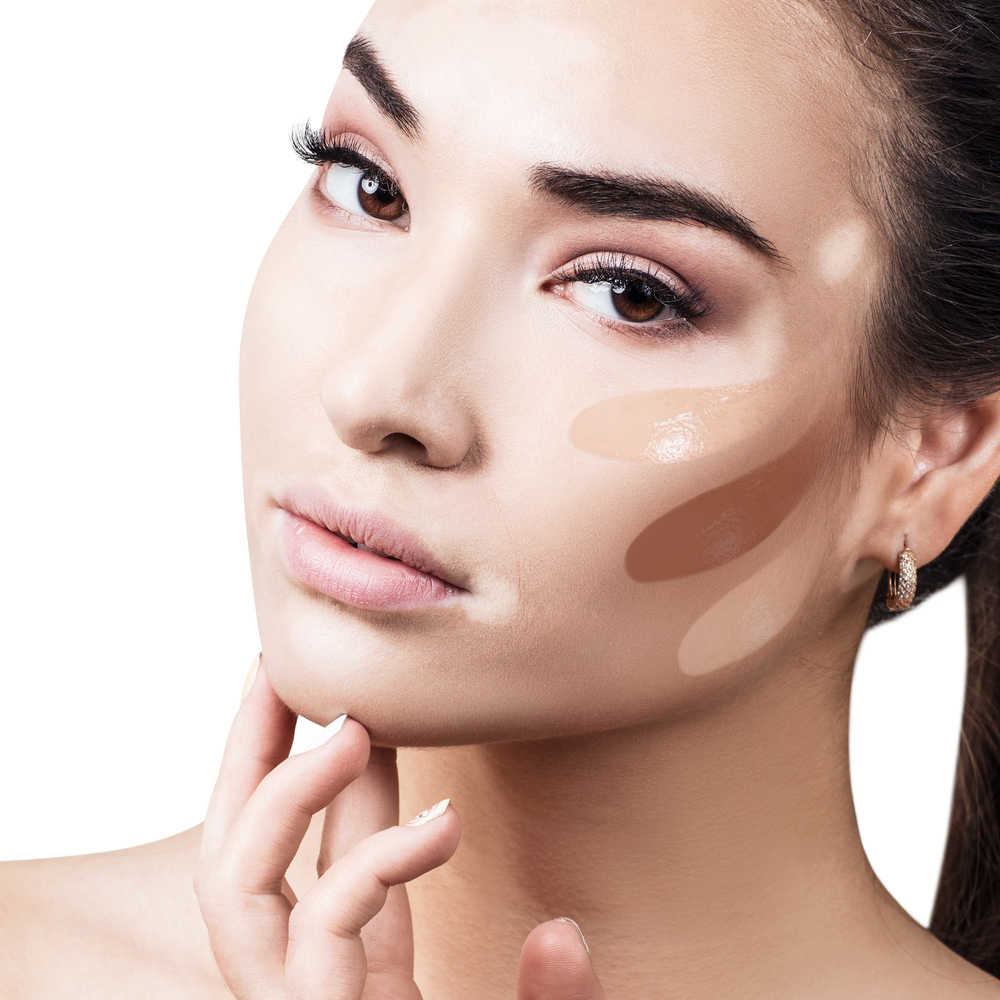Generate single title from this title Vitiligo: Symptoms, causes, and treatment – in 70 -100 characters. And it must return only title i dont want any extra information or introductory text with title e.g: ” Here is a single title:”

Write an article about
With white spots scattered in different places of the face and body, many celebrities did not fear society and reveal their vitiligo disease; This disease, which is a long -term skin condition, where the skin folds its dye and becomes completely lighter or white.
Celebrities faced with courage and hardness, and others became famous for it; From the international Indian star Amithab Bachchan, to the American model, Winnie Harlo, through the Egyptian singer Rami Jamal, the Lebanese businesswoman Karen Wazen, and others who do not accommodate the lines of this article. All of them had the boldness and strength to talk about vitiligo, and to raise awareness about it, of course, in an attempt to break the stereotype that celebrities do not have any problems whose lives are luminous.
Vitiligo affects people of all ages, ethnicities and races around the world. Here is a quick overview of the latest international statistics:
• The global spread rate is estimated at about 0.5% to 1% of the population, although some studies indicate that it may reach 2.28% in some areas.
• This is translated into approximately 70 to 100 million people with vitiligo around the world.
Children make up between 20% and 35% of all cases of vitiligo.
• This condition affects both men and women, and are present in all the ethnic groups.
• The highest vitiligo spread rates in West Asia were recorded to 0.77%; The lowest rates in East Asia were about 0.12%.
• In the United States, the number of people with vitiligo is between 1.9 and 2.8 million people, including non -diagrams.
Although vitiligo is prevalent, it is often a deficient representation in public health discussions. But awareness about it is increasing, as well as research. Every year, specifically on June 25, the International Day of Vitiligo is celebrated; It is a global and local occasion to raise the sound and awareness about this chronic leather disease that affects the appearance of the skin, but its effects may extend to the psychological state, the identity of the affected person, and societal dealing with it.
To stand more on the reasons for this disease; Its causes, symptoms, and methods of treatment, we talked to Dr. Rana Abu Trip, a dermatologist at the University Hospital – Dubai, which passed away with the following information.
What is vitiligo? What happens in the skin when this disease is infected?
Vitiligo is a chronic skin condition, in which spots of the skin lose its dye and become completely lighter or white. This occurs due to the damage of the pigment cells – the cells responsible for the production of melanin, the dye that gives the skin its color – or prevents it properly. This condition can affect any part of the body, but it is more common in the face, hands, arms, feet and around the body openings such as the eyes and mouth. It can also affect hair, and its colors turn white or gray, and even inside the mouth or nose.
It is necessary to note that vitiligo is not considered an infectious or life -threatening disease, but it may leave extreme emotional and psychological effects, especially in societies where the appearance occupies great social importance. Although the exact cause is completely incomprehensible, it is believed to be a self -immune disorder according to what recent studies indicate, and may be associated with genetic factors, stimulate tension, sunburn, or skin injuries.
So, vitiligo is a multi -factor disease, in which several mechanisms overlap, as follows:
1. Self -immune response: the immune system attacks melanosite cells, as in diseases such as alopecia and thyroid gland.
2. Oxidative Stress: which contributes to stimulating the death of pigment cells.
3. Genetic factors: More than 40 genes have been linked to an increase in the risk of vitiligo, most notably the NLRP1 gene.
4. Moderate environmental factors and stimuli: such as wounds, burns, frequent skin infections, or exposure to chemicals.
What are the symptoms of vitiligo?
As mentioned above; One of the most prominent symptoms of vitiligo is the appearance of skin spots that lose its dye, turning into a lighter or completely white color.
Below are the most important symptoms of this disease:
The skin color is irregular, and is often identical on both sides of the body.
• Early whitening or graying of scalp hair, eyelashes, eyebrows and beard.
• Loss of the color of the mucous membranes, such as inside the mouth or nose.
• Changes in the color of the retina or the iris (although the vision is not usually affected).
• Increased sensitivity to sunlight in low -dye areas, which may lead to sunburn.
The condition can develop slowly or quickly, and the extent of the dye loss varies greatly from person to person. Some people may suffer from only small spots, while others may suffer from widespread loss of pigmentation.

Does vitiligo cause itching?
A question that arises, and the answer: It may be! Although itching is not a common width of vitiligo, some people suffer from it, especially in the areas where new spots are formed or where the skin is inflamed. The reason for this itch may be:
1. Dermatitis as a result of targeting the immune system of dye cells.
2. Dryness or irritation of low -dye areas, which are more sensitive to environmental factors such as the sun or wind.
3. Nerve sensitivity, which may increase itching in the affected areas.
It is interesting that some people report shame or burning before the dye loss begins. So, while the vitiligo is not usually painful, these sensations may be early indications of changes. In the event that itching is continuous or annoying, moisturizers, anti -inflammatory creams, or even light therapy may help relieve them.
How does vitiligo affect mental health?
Imagine that your girlfriend, sister, or even your teenage daughter, began to suffer from the appearance of white vitiligo stains in her body and face; What do you imagine her feeling about it?
There is no doubt that the turmoil, fear and anxiety of society’s view of it, which may cause it to cause several emotional and psychological challenges, including:
• Low self -esteem and problems in the image of the body: Many people with vitiligo feel shy or embarrassed, especially in cultures where the appearance is closely related to social acceptance.
• Anxiety and depression: Studies show that people with vitiligo have higher rates of anxiety and depression, especially when vitiligo affects more than 5% of the surface of the body, or when the condition appears on the face or hands.
• Social withdrawal and isolation: Fear of judgment or misunderstanding people may push people to avoid social situations, which may deepen the feelings of unity.
Stigma and Discrimination: In some societies, vitiligo is still misunderstood; Which leads to the spread of harmful myths or social exclusion, which may be especially harmful to adolescents and dark -skinned people.
On the other hand, many find strength and flexibility through support groups, psychotherapy and self -acceptance. Mental health specialists often recommend cognitive behavioral therapy (CBT), mental vigilance practices, and communicate with others who share similar experiences, to help build self -confidence and enjoy the emotional luxury they deserve.
How is vitiligo diagnosed?
The diagnosis is often clinical, and is reinforced using tools such as:
1. Answar examination: The dermatologist usually examines the skin, in search of distinctive white spots.
2. Wood Lamp: This ultraviolet light helps to highlight the ultra -dyed areas, especially on light skin levels.
3.
4. Blood tests: These tests can reveal the accompanying autoimmune diseases, such as thyroid diseases, diabetes, or anemia.

Is it possible to treat vitiligo?
Unfortunately, there is no final treatment for vitiligo; But there are currently available treatments with multiple options to improve appearance, slow or fix the condition, re -pigmentation, as well as improve the psychological and social condition.
These options include the following:
1. topical treatments: using cortisone creams for small areas and in the early stages of the disease. Including Pimecrolimus and Tacrolimus creams that are effective and safe, especially on the face and sensitive areas.
2. Photo therapy: It is done 2-3 times a week.
3. Surgical therapy: In which the skin or melanostite is implanted for fixed cases for more than a year.
4. Micro-Pigmentation: for small areas such as lips.
5. Empty removal: In cases where vitiligo is covered most body, creams are used to lighten the remaining dark skin (monobenzone).
What are the latest developments in modern medicine regarding vitiligo?
Vitiligo treatment has witnessed remarkable progress recently, especially with the appearance of JAK inhibitors, a group of drugs that modify the immune system:
• Ruxolitinib (Obselora): It is the first localized vitiligo treatment of the American Food and Drug Administration, and has shown promising results in restoring the dye, especially on the face. About 50% of the users of this treatment have witnessed a noticeable return of pigmentation after one year of continuous use.
• Stem cell therapy and textile injections: are still under study
How should you deal with vitiligo?
Studies indicate that about 60% of vitiligo patients suffer from social anxiety, low self -esteem and depression; Therefore, Dr. Rana and Fakih University Hospital stresses the importance of providing psychological support, guidance, and community support groups in addition to medical treatment.
Also, these patients can follow some daily advice that reduce the burden of this condition on their psychological and physical health, including:
1. Use a wide -spectrum sunscreen with 50+ protection laboratory.
2. Avoid exposure to the sun at peak.
3. Wearing protective clothes.
4. Acceptance of self and promoting self -confidence.
in conclusion; Dr. Abu Trip sends a message to all the readers of “she” and those interested in their health and the health of their loved ones, on the International Day of Vitiligo: “As a dermatologist, I see every day how a skin disease like vitiligo can change the patient’s life not only in his appearance, but in his view of himself. So my message to every patient: your different color is part of you A sign of your steadfastness and true beauty. “
.Organize the content with appropriate headings and subheadings (h1, h2, h3, h4, h5, h6). Include conclusion section and FAQs section at the end. do not include the title. it must return only article i dont want any extra information or introductory text with article e.g: ” Here is rewritten article:” or “Here is the rewritten content:”

